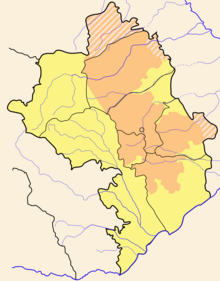亞美尼亞控制的納戈爾諾-卡拉巴赫周邊地區
外觀

亞美尼亞控制的納戈爾諾-卡拉巴赫周邊地區是阿塞拜疆法理上的領土,位於納戈爾諾-卡拉巴赫自治州周圍,自納戈爾諾-卡拉巴赫戰爭結束至2020年納戈爾諾-卡拉巴赫戰爭前,這些地區一直由亞美尼亞扶持的阿爾察赫共和國軍隊控制[1][2][3][4][5]。阿爾察赫實際上是擁有人民、領土、政府和主權的獨立國家,甚至擁有自己的軍隊與貨幣、及自行發行護照與簽證。
歷史
[編輯]2008年,聯合國大會通過第62/243號決議,要求亞美尼亞軍隊從阿塞拜疆被佔領土撤出。[6]與納戈爾諾-卡拉巴赫自治州不同,亞美尼亞控制的納戈爾諾-卡拉巴赫周邊地區的人口以阿塞拜疆人為主。[7]
2020年
[編輯]2020年9月27日的早晨,二次戰爭在納哥諾卡拉巴克邊界地區接觸線展開,最終該場戰爭以阿塞拜疆勝利並控制阿塞拜疆-伊朗邊境告終。[8]
根據2020年納戈爾諾-卡拉巴赫停火協議結束後,亞美尼亞部隊同意在2020年12月1日之前從這些地區撤出,將其歸還給阿塞拜疆。作為交換條件,阿塞拜疆允許亞美尼亞人通過拉欽走廊往來於亞美尼亞本土和納戈爾諾-卡拉巴赫之間[9]。
另見
[編輯]參考文獻
[編輯]- ^ Сергей Маркедонов: Нужны ли российские миротворцы в Нагорном Карабахе. ПОЛИТ.РУ. 2006-06-02 [2020-11-13]. (原始內容存檔於2020-11-13).
- ^ GENERAL. www.hrw.org. [2020-11-13]. (原始內容存檔於2016-03-03).
By early 1992 full-scale fighting broke out between Nagorno-Karabakh Armenians and Azerbaijani authorities." "...Karabakh Armenian forces -often with the support of forces from the Republic of Armenia- conducted large-scale operations..." "Because 1993 witnessed unrelenting Karabakh Armenian offensives against the Azerbaijani provinces surrounding Nagorno-Karabakh..." "Since late 1993, the conflict has also clearly become internationalized: in addition to Azerbaijani and Karabakh Armenian forces, troops from the Republic of Armenia participate on the Karabakh side in fighting inside Azerbaijan and in Nagorno-Karabakh.
- ^ Hsw. www.hrw.org. [2020-11-13]. (原始內容存檔於2015-02-18).
In 1992 the conflict grew far more lethal as both sides -the Azerbaijani National Army and free-lance militias fighting along with it, and ethnic Armenians and mercenaries fighting in the Popular Liberation Army of Artsakh- began...
- ^ Nagorno-Karabakh Searching for a Solution. U.S. Institute of Peace. [2020-11-13]. (原始內容存檔於2008-12-02).
Nagorno-Karabakh’s armed forces have not only fortified their region but have also occupied a large swath of surrounding Azeri territory in the hopes of linking the enclave to Armenia.
- ^ Sovereignty after Empire: Peaceworks. U.S. Institute of Peace. [2020-11-13]. (原始內容存檔於2009-06-11).
Meanwhile, the conflict over Nagorno-Karabakh was gradually transforming into a full-scale war between Azeri and Karabakh irregulars, the latter receiving support from Armenia." "Azerbaijan's objective advantage in terms of human and economic potential has so far been offset by the superior fighting skills and discipline of Nagorno-Karabakh's forces. After a series of offensives, retreats, and counteroffensives, Nagorno-Karabakh now controls a sizable portion of Azerbaijan proper (...), including the Lachin corridor.
- ^ 62/243. The situation in the occupied territories of Azerbaijan. undocs.org. United Nations General Assembly. 25 April 2008 [31 October 2020]. (原始內容存檔於1 November 2020).
- ^ население азербайджана. ETHNO-CAUCASUS. 2011-03-20 [2023-09-21]. (原始內容存檔於2012-03-28) (柯爾克孜語).
- ^ Armenia/Azerbaijan – Border clashes between the two countries (15 Jul. 2020). Ministry of Europe and Foreign Affairs (France). [27 September 2020]. (原始內容存檔於2020-12-09) (英語).
- ^ Moscow confirms peace deal signed, complete cessation of hostilities.. The Moscow Times. 9 November 2020. (原始內容存檔於2020-11-15).
